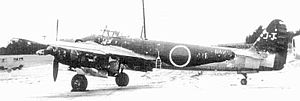Nakajima J5N Video - Picture

|
|
Nakajima J5N
Nakajima J5N

Picture - Nakajima J5N1 Tenrai
Role: Interceptor
Manufacturer: Nakajima Aircraft Company
Designed by: Katsuji Nakamura, Kazuo Ohno
First flight: July, 1944
Primary user: Imperial Japanese Navy
Number built: 6
During the spring of 1943, the JNAF issued an 18-Shi specification for a single-seat twin-engine interceptor capable of reaching a top speed of 666 km/h (414 mph) at 6,000 m (19,690 ft). Nakajima submitted a proposal based on the earlier J1N1 Gekko three-seat night fighter, although this new aircraft - designated J5N1 - was slightly smaller. The layout of the J5N was similar to the J1N: a low set wing on which were mounted the two powerplants, 1,484 kW (1,990 hp) Nakajima Homare 21 18-cylinder air-cooled radial engines, with a long fuselage ending in a conventional tail arrangement. For maximum utilization of the power from the twin engines, large four-blade propellers were fitted which also featured large spinners (as fitted to the J1N). The main wheels retracted rearwards into the engine nacelles, and the tailwheel was fixed. The cockpit was set above the wing, and featured a starboard-opening canopy. The nose was streamlined to offer the pilot an excellent forward view during landing, take-off and taxiing.
The armament of the J5N consisted of two 30 mm and two 20 mm cannon, and provision was made for a centreline 250 kg (550 lb) bomb. The J5N was designed to combat the heavily-armed US fighters in the Pacific Theatre at that time, and this impressive armament would have done severe damage to these aircraft. To concentrate the firepower, the four cannons were mounted in the nose of the J5N.
Impressed with the design, the JNAF authorized the development of the J5N1, assigned the name Tenrai ("Heavenly Thunder"), and six prototypes were requested to be built. The first prototype - lacking its armament - made its first flight July 13, 1944, and was something of a disappointment. The top speed attained was only 597 km/h (371 mph) - far below the specified 666 km/h (414 mph) of the requirement. Despite the other five prototypes flying as well, with numerous enhancements, the aircraft never achieved its design speed, and the project was abandoned soon after.
Variants
J5N1 : Single-seat interceptor fighter aircraft. Six built.
Specifications (J5N1)
General characteristics
Crew: one, pilot
Length: 11.46 m (37 ft 7 in)
Wingspan: 14.00 m (45 ft 11 in)
Height: 2.38 m (7 ft 9 in)
Wing area: 32 m² (344 ft²)
Empty weight: 5,195 kg (11,429 lb)
Loaded weight: 7,350 kg (16,170 lb)
Powerplant: 2x— Nakajima Homare 21 18-cylinder radial engines, 1,485 kW (1,990 hp) each
Performance
Maximum speed: 619 km/h (387 mph)
Rate of climb: 900 m/min (2,950 ft/min)
Wing loading: 230 kg/m² (47 lb/ft²)
Power/mass: 0.40 kW/kg (0.24 hp/lb)
Armament
2 x— 30 mm cannon and/or 2 x— 20 mm Type 99-2 cannon
1 x— 250 kg (551 lb) bomb
Bibliography
Francillon, Réne J. Japanese Aircraft of the Pacific War. London: Putnam & Company Ltd., 1970 (2nd edition 1979). ISBN 0-370-30251-6.
Green, William. Warplanes of the Second World War, Volume Three: Fighters. London: Macdonald & Co.(Publishers) Ltd., 1961. ISBN 0-356-1447-9.
Townend, David R. Thunderbolt & Lightning. Markham: AeroFile Publications, 2008, ISBN 978-0-9732020-2-1.
Nakajima J5N Pictures
Living Warbirds: The best warbirds DVD series.
Source: WikiPedia